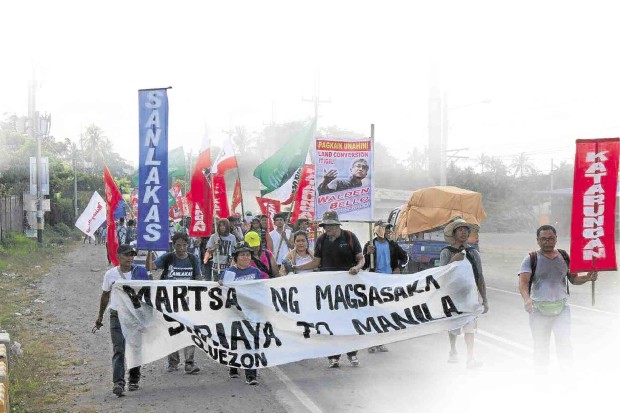
FARMERS on a protest march for genuine land reform and the return of coconut levy reach the Marharlika Highway in Quezon province after starting their 122-km journey on foot to Manila in the town of Sariaya. CONTRIBUTED PHOTO
Heat associated with the El Niño phenomenon is taking its toll on a group of farmers currently on a 122-kilometer journey by foot to Manila to demand the return of levy forcibly collected from coconut farmers by the Marcos dictatorship and a genuine implementation of agrarian reform.
As of Thursday, the third day of the protest march, at least eight farmers, aged more than 60 years old and six of whom are women, were forced to quit walking as temperatures soared close to 40 degrees Celsius and the heat index went further past that.
“Their blood pressures rose to dangerous levels,” said Jansepth Geronimo, spokesperson of the militant organization Kilusan para sa Tunay na Repormang Agraryo at Katarungang Panlipunan (Katarungan).
Geronimo, in a phone interview, said the weakened marchers wanted to continue “but we prevented them for their own safety.”
One of the elderly marchers, said Geronimo, had to be brought back to his hometown in San Andres, Quezon province, after getting first aid treatment.
He said seven other marchers were given medical checkup in backup vehicles. “But once they had rested, they again joined the march,” Geronimo said.
The farmers are walking in temperatures that are almost halfway to water’s boiling point.
But the discomfort, or even health risks associated with such intense heat are the least of the concerns of the more than 200 farmers who marched from Sariaya town in Quezon province.
They are demanding the return of at least P70 billion in money forcibly collected from coconut farmers during the heyday of the Marcos dictatorship.
“The scorching heat is making the march really difficult,” said Geronimo, who is also one of the leaders of the march.
“We have to drink lots of water,” he said.
He expressed concern over the effects on the marchers’ health of the severe heat caused by El Niño and carbon monoxide emitted by vehicles on roads where the farmers march.
“Despite these, we remain in high spirits,” said Geronimo. “Some even sing as they march,” he said.
The Philippine Atmospheric, Geophysical and Astronomical Services Administration (Pagasa) forecast temperatures higher than usual for the country because of El Niño.
Geronimo said several health workers who had joined the march were monitoring the condition of the marchers.
The farmers started the second day of their 122-km trek to Manila with a 16-km hike from Tiaong town in Quezon to San Pablo City in Laguna province.
Fr. Vic Aller, parish priest of St. John the Baptist church in Tiaong, prayed for and blessed the farmers.
On the first day of the march, former Akbayan Rep. Walden Bello, who is running for senator, led more than 1,000 farmers from Sariaya who accompanied the marchers up to the boundary of Candelaria town.
Geronimo thanked residents along the Maharlika Highway who gave the marchers water and food. He said some coconut farmers along the route also gave the marchers fresh buko (young coconut) water.
Maribel Luzara, head of the farmers group Kilusang Magbubukid ng Bondoc Peninsula that joined the march, said she was asking residents along their route to keep helping the marchers by giving food and water.
“These would help boost our morale and resolve to go on,” said Luzara, whose group is waging a legal battle to compel a landlord in San Francisco town in Quezon to implement fully the government’s agrarian reform program.
Romeo Clavo, head of the farmers’ group Ugnayan ng Magsasaka sa Gitnang Quezon (Ugnayan) based in Sariaya town, vowed to complete the march to stop the revocation of land titles already given by the government to farmers as part of the agrarian reform program.